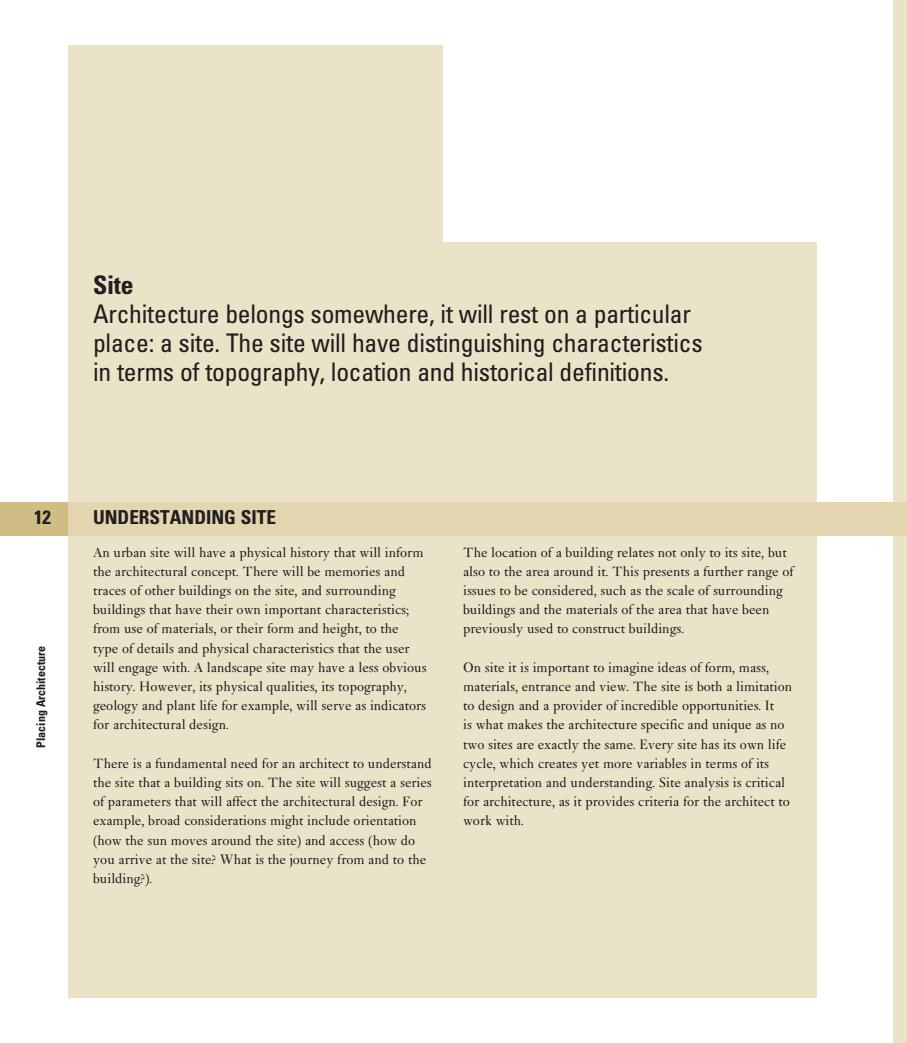正在加载图片...

Site Architecture belongs somewhere,it will rest on a particular place:a site.The site will have distinguishing characteristics in terms of topography,location and historical definitions. 12 UNDERSTANDING SITE An urban site will have a physical history that will inform The location of a building relates not only to its site,but the architectural concept.There will be memories and also to the area around it.This presents a further range of traces of other buildings on the site,and surrounding issues to be considered,such as the scale of surrounding buildings that have their own important characteristics; buildings and the materials of the area that have been from use of materials,or their form and height,to the previously used to construct buildings. type of details and physical characteristics that the user will engage with.A landscape site may have a less obvious On site it is important to imagine ideas of form,mass, history.However,its physical qualities,its topography, materials,entrance and view.The site is both a limitation geology and plant life for example,will serve as indicators to design and a provider of incredible opportunities.It Buyoeld for architectural design. is what makes the architecture specific and unique as no two sites are exactly the same.Every site has its own life There is a fundamental need for an architect to understand cycle,which creates yet more variables in terms of its the site that a building sits on.The site will suggest a series interpretation and understanding.Site analysis is critical of parameters that will affect the architectural design.For for architecture,as it provides criteria for the architect to example,broad considerations might include orientation work with. (how the sun moves around the site)and access(how do you arrive at the site?What is the journey from and to the building?)Job No: D0312-18 / YEE PEI 1st Proof Title: Fund Architecture 2nd Edition (AVA) 76451_CTP_001-045GK_2Mar_.indd 12 Text 3/13/12 4:45 PM Black Site Architecture belongs somewhere, it will rest on a particular place: a site. The site will have distinguishing characteristics in terms of topography, location and historical definitions. UNDERSTANDING SITE An urban site will have a physical history that will inform the architectural concept. There will be memories and traces of other buildings on the site, and surrounding buildings that have their own important characteristics; from use of materials, or their form and height, to the type of details and physical characteristics that the user will engage with. A landscape site may have a less obvious history. However, its physical qualities, its topography, geology and plant life for example, will serve as indicators for architectural design. There is a fundamental need for an architect to understand the site that a building sits on. The site will suggest a series of parameters that will affect the architectural design. For example, broad considerations might include orientation (how the sun moves around the site) and access (how do you arrive at the site? What is the journey from and to the building?). The location of a building relates not only to its site, but also to the area around it. This presents a further range of issues to be considered, such as the scale of surrounding buildings and the materials of the area that have been previously used to construct buildings. On site it is important to imagine ideas of form, mass, materials, entrance and view. The site is both a limitation to design and a provider of incredible opportunities. It is what makes the architecture specific and unique as no two sites are exactly the same. Every site has its own life cycle, which creates yet more variables in terms of its interpretation and understanding. Site analysis is critical for architecture, as it provides criteria for the architect to work with. Placing Architecture 12 Job No: D0312-18 / YEE PEI 1st Proof Title: Fund Architecture 2nd Edition (AVA) 76451_CTP_001-045GK_2Mar_.indd 12 3/13/12 4:46 PM